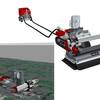Decommissioning in Shetland Expands
Two installations from Spirit Energy’s ST-1 in the North Sea have arrived at the Dales Voe decommissioning facility in Shetland, Scotland, with works set to be carried out by partners Veolia and Peterson.
The 45-metre high 1,300 tonne steel jacket and 1,200 tonne topsides structure arrived into Dales Voe in Lerwick.
The structures will be dismantled and disposed of by partners Veolia and Peterson.
Now at the end of their working life recovering these platforms is important to maximize the value of the materials and assets they contain, and further the sustainability of the offshore industry.
With a recycling target of 97% the project includes recovery of approximately 2,500 tonnes of materials that will be carefully extracted and returned to industry, and where possible assets that have further operational life will be sold for re-use.
ST-1, comprising of a 45 metre high 1,300 tonne steel jacket and 1,200 tonne topsides structure, was originally installed in 1994 in the Greater markham Area 160km off the coast in the Southern North Sea.
Comprising three levels including a cellar and accommodation unit, the weather deck with pedestal crane, and a mezzanine deck, production on this gas platform ceased in April 2016 and was placed in warm suspension mode in September 2017.
The final part of the decommissioning programme, covering the removal of the topsides and jackets, was carried out through two single lifts by Seaway 7, the Renewables and Heavy lifting business unit of Subsea 7, using the Seaway Strashnov heavy lifting vessel.
Successful delivery onshore further highlights the key receipt strength at Dales Voe which includes a 60 tonnes/m2 strong quay.
Veolia decommissioning director Martin O’Donnell said of the ST-1 job: “This work follows the successful recovery operations carried out at the facility, and really demonstrates how collaboration across the supply chain can deliver greater sustainability. We have already recycled over 80,000 tonnes of materials and created new job opportunities to meet the growing demand for decommissioning.”













